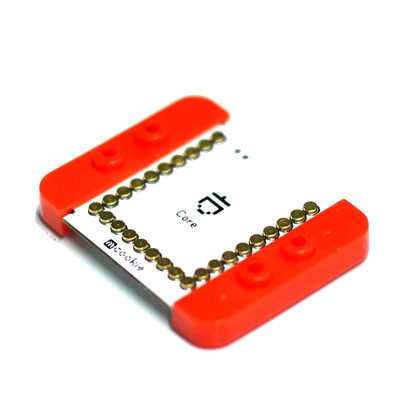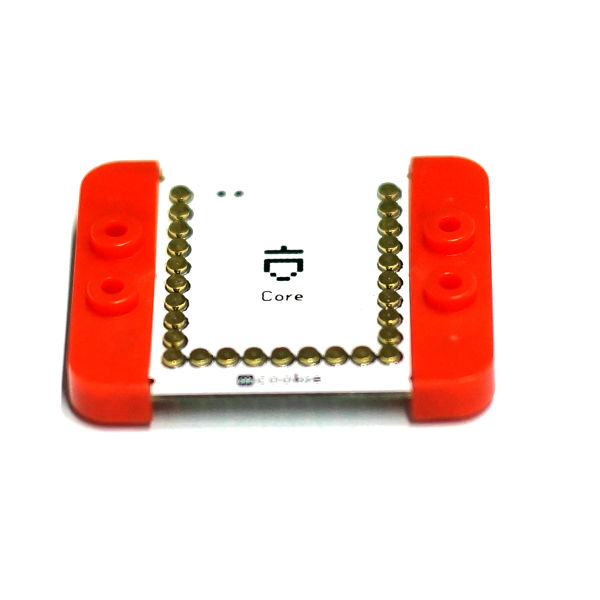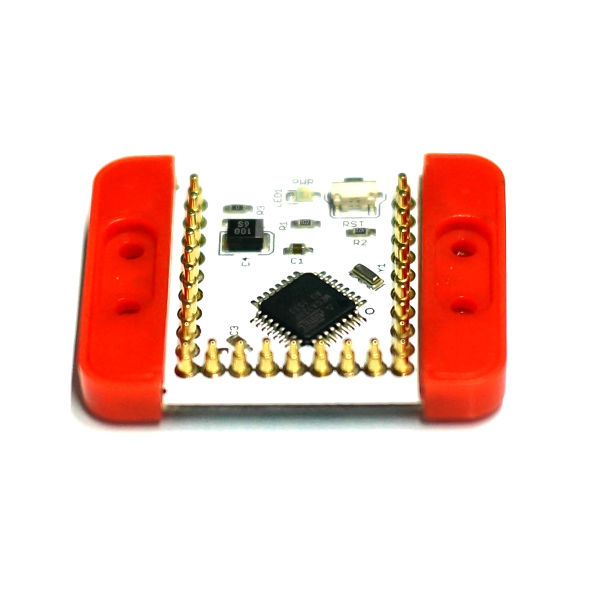|
Microduino-Core is an 8-bit microcontroller development board, with the core of Atmel ATmega328P series. It is a open-source, compatible-with-Arduino UNO Microduino-Core controller module.
Features
- Small, cheap, stackable, open, and compatible-with-Lego.
- The open-source hardware circuit design and compatible-with-Arduino programming environment;
- The unified mCookie interface specification and abundant peripheral modules, which make it can be quickly extended and connected with other modules and sensors which meet the Microduino/mCookie interface specification, conveniently and flexibly;
|
Specification
- There are two versions of mCookieo-Core now, according to different cores and clock frequency:
| Type
|
Flash
|
SRAM
|
EEPROM
|
Clock Frequency
|
Working Voltage
|
| Atmega328P@16M,5V
|
32K
|
2K
|
1K
|
16M
|
5.0V
|
| ATmega328P@8M,3V3
|
32K
|
2K
|
1K
|
8M
|
3.3V
|
- There are 22 Digital I/O:
- On the module labeled D0, D1, D2~D13 and A0~A7, during which A6 and A7 can only be taken as input, not output.
- There are 8 Analog I/O:
- On the module labeled A0~A7;
- Each provides 10 resolution ratio(that is 0~1024). By default, the measurement range of the analog voltage is the value from GND to VCC;
- Please refer to analogRead()function for details.
- There are 6 PWM supporters:
- On the module labeled D3, D5, D6, D9, D10, and D11 respectively.
- Please refer to analogWrite() function for details.
- There is one serial port supporter:
- On the module labeled Serial[D0(RX),D1(TX)].
- Connected with USBTTL module will occupy D0 and D1. If ports D0 and D1 are also occupied by other modules, the communication with USBTTL will be abnormal and the program will be unable to be downloaded.
- There is one SPI supporter:
- On the module labeled D13(SCK), D12(MISO), D11(MOSI), and D10(SS).
- There is one I2C supporter:
- On the module labeled SDA(A4),SCL(A5).
- There are 2 external interrupt supporter:
- On the module labeled D2(interrupt0) and D3(interrupt1).
- Please refer to attachInterrupt()function for details.
- Support ISP download function.
| Pin
|
Original Pin Name
|
Map Pin Name
|
Digital Pin
|
Analog Pin
|
interrupt
|
PWM
|
Serial
|
SPI
|
I2C
|
Power
|
| 1 |
VCC |
+5V |
|
|
|
|
|
|
|
+5V
|
| 2 |
VCC |
+3V3 |
|
|
|
|
|
|
|
+3.3V
|
| 3 |
(AIN1)PD7 |
D7 |
D7 |
|
|
|
|
|
|
|
| 4 |
(ICP)PB0 |
D8 |
D8 |
|
|
|
|
|
|
|
| 5 |
(OC1A)PB1 |
D9 |
D9 |
|
|
yes |
|
|
|
|
| 6 |
(OC1B/SS)PB2 |
D10 |
D10 |
|
|
yes |
|
SS |
|
|
| 7 |
(OC2A/MOSI)PB3 |
D11 |
D11 |
|
|
yes |
|
MOSI |
|
|
| 8 |
(MISO)PB4 |
D12 |
D12 |
|
|
|
|
MISO |
|
|
| 9 |
(SCK)PB5 |
D13 |
D13 |
|
|
|
|
SCK |
|
|
| 10 |
AREF |
AREF |
|
|
|
|
|
|
|
|
| 11 |
(ADC0)PC0 |
A0 |
D14 |
A0 |
|
|
|
|
|
|
| 12 |
(ADC1)PC1 |
A1 |
D15 |
A1 |
|
|
|
|
|
|
| 13 |
(ADC2)PC2 |
A2 |
D16 |
A2 |
|
|
|
|
|
|
| 14 |
(ADC3)PC3 |
A3 |
D17 |
A3 |
|
|
|
|
|
|
| 15 |
(ADC4/SDA)PC4 |
SDA |
D18 |
A4 |
|
|
|
|
SDA |
|
| 16 |
(ADC5/SCL)PC5 |
SCL |
D19 |
A5 |
|
|
|
|
SCL |
|
| 17 |
(ADC6) |
A6 |
D20(only input) |
A6 |
|
|
|
|
|
|
| 18 |
(ADC7) |
A7 |
D21(only input) |
A7 |
|
|
|
|
|
|
| 19 |
(RXD)PD0 |
D0 |
D0 |
|
|
|
0(RX) |
|
|
|
| 20 |
(TXD)PD1 |
D1 |
D1 |
|
|
|
0(TX) |
|
|
|
| 21 |
(INT0)PD2 |
D2 |
D2 |
|
0 |
|
|
|
|
|
| 22 |
(OC2B/INT1)PD3 |
D3 |
D3 |
|
1 |
yes |
|
|
|
|
| 23 |
(XCK/T0)PD4 |
D4 |
D4 |
|
|
|
|
|
|
|
| 24 |
(OC0B/T1)PD5 |
D5 |
D5 |
|
|
yes |
|
|
|
|
| 25 |
(OC0A/AIN0)PD6 |
D6 |
D6 |
|
|
yes |
|
|
|
|
| 26 |
RESET |
RST |
|
|
|
|
|
|
|
|
| 27 |
GND |
GND |
|
|
|
|
|
|
|
GND
|
|
Documents
Development
- 1.To download programs to mCookie-Core, players need to use mCookie-USBTTL.
- 2.The tutorial of setting development environment and installing the driver is as following:
Application
MCookie_(Microduino compatible board)tutorial
FAQ
- Q:How to judge the voltage of the Core in my hand is 3.3V of 5V?
- A:You can judge from the resistance. If the R1 is welded on, it is 3.3V. And if R2 is welded, it is 5V.
- Q:Can I use 3.3V electricity to supply power to Core+, the clock frequency of which is 16M?
- A:It isn’t recommended. If the voltage is too low, it will be unstable.
- Q:Can I use 5V voltage electricity to supply power to Core, the clock frequency of which is 8M?
Purchase
|
History
Microduino-Core
Gallery
|
|
|


